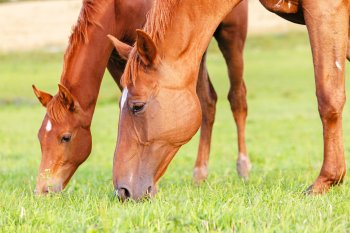NUTRITION OF HORSES
HAY - Hay is fed twice a day to horses or kept always available. Horses on open pastures may be offered hay depending on their grass grazing. Hay is dried grass that has been grown commercially with fertilizer and irrigation (watering system) to have the best amount of protein. Hay is cut about every 28 to 30 days when it is fine stemmed for better digestion. After grass hay is matured the farmer cuts the grass forming rolls in the field. He allows the sun to dry the moist green grass. On the second day a tractor travels down the row of hay rolls and flips them over with an automatic hay rake attached to the tractor. By turning the grass hay over, this helps it finish drying the other side. The farmer allows the sun to dry the moist grass for approximately 3 days total. Hay cannot be baled with too much moisture content or it will become moldy. If the hay is rained on it will also become moldy. Then when pulled apart the hay will have a distinctive bad moldy odor that does not smell good. The appearance of the hay will be brownish it will also be matted together in spots. Horses are given top quality hay. You can tell by pulling apart the hay that it is good quality if it has a good smell and flakes apart easily. If you give moldy hay to a horse in the pasture he will sniff it and think to himself “I'm not eating this bad food” and he will then go looking for grass, leaves and bark off of trees to eat. If you feed bad hay to a horse in a stall he will eat it because otherwise he would starve (he has no choice). So make sure you are feeding him good quality hay. Feeding moldy or bad feed causes colic in horses. Colic is number one in deaths of horses.
Alfalfa hay is very high in protein. They are given a small quantity and then gradually add more until their digestive system gets accustomed to the rich hay. Always keep feed LOCKED up so if horse gets loose from stall he will not find his way into the feed. This can be deadly for horses. Horses that over eat may develop founder.
GRAINS - Horse feed is a concentrated type feed. They range in higher protein for active horses to lower for inactive horses (10 % to 14%). All feeds are different and each bag has a label attached so you may read exactly what is in each bag. The label states the percentage of protein, carbohydrates, minerals, vitamins and roughage contained in each bag. Keep your horse with the same type and brand. Horses have very sensitive digestive systems and sudden change in feed could be deadly. Horses are fed twice and some three times a day. The amount you feed depends on each individual horse. Heavy horses are fed less and thin horses where you can see the ribs, are fed more. Horses that are not accustomed to grains are started off with grains very gradually so they will not colic or founder by giving too much grain. We may start out as ¼ of a 3 lb coffee can twice a day. Then gradually move them up in amount weeks and months at a time. Always stay with the same feed. Try not to change feed brand or type. If you change the feed type or brand suddenly, you may upset their digestive system. If feeding one type of feed and wanting to change:
Avoid Sudden Feed Changes: If a change of feed occurs, it takes about three weeks to develop a microbial population that can digest a new feed and maintain a normal flow through the cecum. A general rule for safely changing feeds:
Week 1: Feed a mix of three-fourths of the old ration and one-fourth of the new feed.
Week 2: Feed a mix of one-half of the old ration and one-half of the new feed.
Week 3: Feed a mix of one-fourth of the old ration and three-fourths of the new feed.
Week 4: Feed all new feed.
Grains can also become moldy. It is important to rotate your feed. This means if you have 2 sacks of feed left and you go and purchase 3 more sacks, place the new sacs at the bottom and move the 2 older sacks to the top to be used first. Old or moldy grain may cause horses to colic.
You may feed horses as much HAY as they can eat. It is like the mashed potato portion of the meal with no butter or gravy. They just eat what they need if they feel hungry. The Grain is like the steak portion of the meal. You feed grains in prescribed amounts. Always keep feed room closed and latched up so horses won't be able to enter, especially if they managed to escape from their pen, stall or pasture.
Reba Martinez – Horse Sense Solutions, the makers of product SayWhoa!


